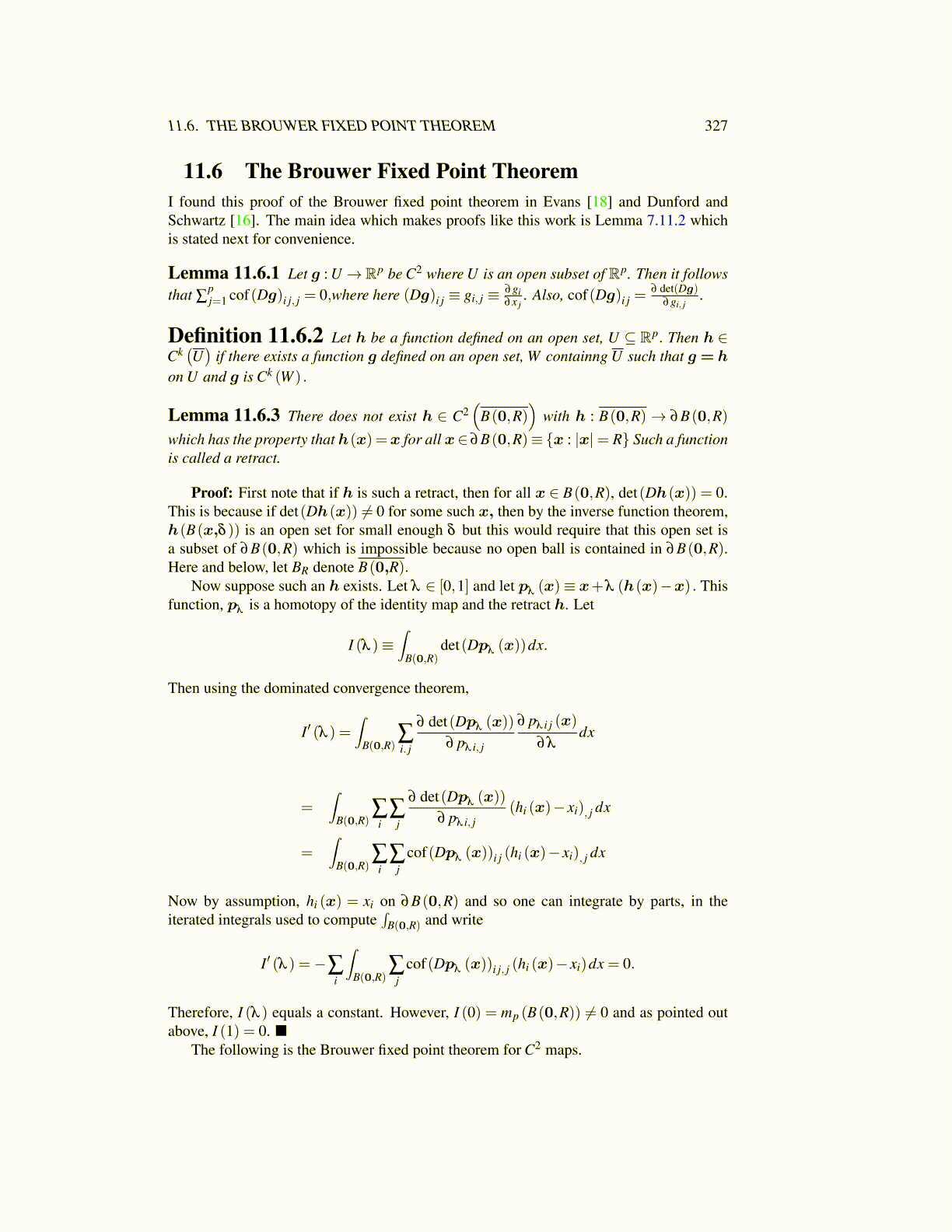
11.6. THE BROUWER FIXED POINT THEOREM 327
11.6 The Brouwer Fixed Point TheoremI found this proof of the Brouwer fixed point theorem in Evans [18] and Dunford andSchwartz [16]. The main idea which makes proofs like this work is Lemma 7.11.2 whichis stated next for convenience.
Lemma 11.6.1 Let g : U →Rp be C2 where U is an open subset of Rp. Then it followsthat ∑
pj=1 cof(Dg)i j, j = 0,where here (Dg)i j ≡ gi, j ≡ ∂gi
∂x j. Also, cof(Dg)i j =
∂ det(Dg)∂gi, j
.
Definition 11.6.2 Let h be a function defined on an open set, U ⊆ Rp. Then h ∈Ck(U)
if there exists a function g defined on an open set, W containng U such that g= h
on U and g is Ck (W ) .
Lemma 11.6.3 There does not exist h ∈ C2(
B(0,R))
with h : B(0,R)→ ∂B(0,R)
which has the property that h(x) =x for all x∈ ∂B(0,R)≡{x : |x|= R} Such a functionis called a retract.
Proof: First note that if h is such a retract, then for all x ∈ B(0,R), det(Dh(x)) = 0.This is because if det(Dh(x)) ̸= 0 for some such x, then by the inverse function theorem,h(B(x,δ )) is an open set for small enough δ but this would require that this open set isa subset of ∂B(0,R) which is impossible because no open ball is contained in ∂B(0,R).Here and below, let BR denote B(0,R).
Now suppose such an h exists. Let λ ∈ [0,1] and let pλ (x)≡ x+λ (h(x)−x) . Thisfunction, pλ is a homotopy of the identity map and the retract h. Let
I (λ )≡∫
B(0,R)det(Dpλ (x))dx.
Then using the dominated convergence theorem,
I′ (λ ) =∫
B(0,R)∑i. j
∂ det(Dpλ (x))
∂ pλ i, j
∂ pλ i j (x)
∂λdx
=∫
B(0,R)∑
i∑
j
∂ det(Dpλ (x))
∂ pλ i, j(hi (x)− xi), j dx
=∫
B(0,R)∑
i∑
jcof(Dpλ (x))i j (hi (x)− xi), j dx
Now by assumption, hi (x) = xi on ∂B(0,R) and so one can integrate by parts, in theiterated integrals used to compute
∫B(0,R) and write
I′ (λ ) =−∑i
∫B(0,R)
∑j
cof(Dpλ (x))i j, j (hi (x)− xi)dx = 0.
Therefore, I (λ ) equals a constant. However, I (0) = mp (B(0,R)) ̸= 0 and as pointed outabove, I (1) = 0. ■
The following is the Brouwer fixed point theorem for C2 maps.